Digital Forensics: Challenges and Methodologies in Cloud Computing
VerifiedAdded on 2019/09/23
|9
|1912
|32
Report
AI Summary
This report delves into the realm of digital forensics within cloud computing environments. It begins by highlighting the increasing interest in cloud computing and its implications for law enforcement, emphasizing the need for data preservation and forensic methodologies. The report explores the challenges posed by virtualisation and the evolution of cybercrimes, which necessitate advanced digital forensic techniques. It discusses the application of digital forensic practices, focusing on the complexities of data distribution and jurisdiction. The report also examines the various cloud deployment models (public, private, hybrid, community) and service layers (IaaS, PaaS, SaaS), emphasizing the importance of understanding these models for effective forensic investigations. It then outlines the methodologies involved in data collection, including the acquisition of data from cloud servers, the establishment of chain of custody, and the use of digital forensic tools. The report concludes by addressing the need for frameworks that can help overcome the challenges related to data acquisition, access to information, and the development of monitoring tools, with the ultimate goal of improving forensic readiness in cloud computing.
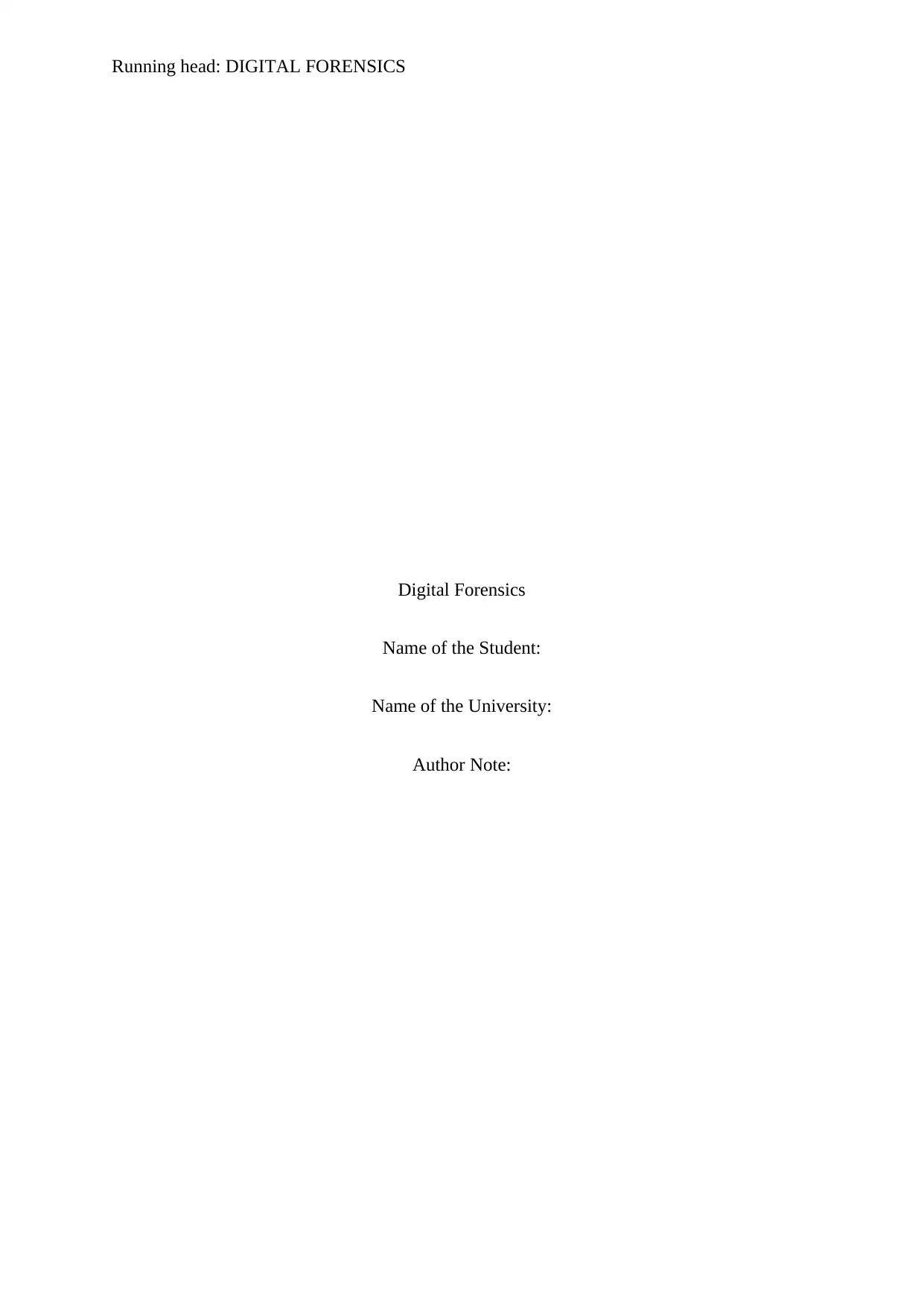
Running head: DIGITAL FORENSICS
Digital Forensics
Name of the Student:
Name of the University:
Author Note:
Digital Forensics
Name of the Student:
Name of the University:
Author Note:
Paraphrase This Document
Need a fresh take? Get an instant paraphrase of this document with our AI Paraphraser
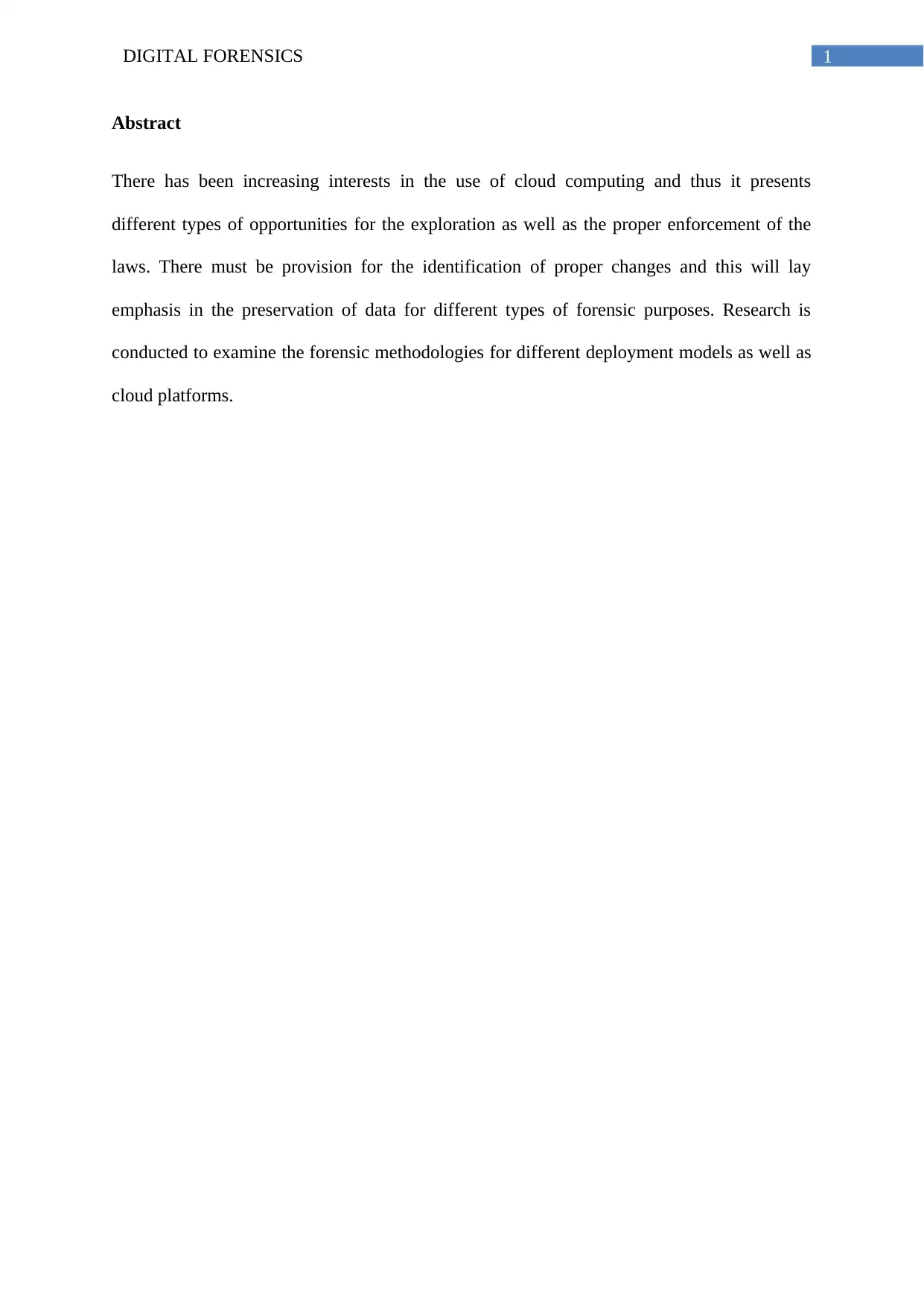
1DIGITAL FORENSICS
Abstract
There has been increasing interests in the use of cloud computing and thus it presents
different types of opportunities for the exploration as well as the proper enforcement of the
laws. There must be provision for the identification of proper changes and this will lay
emphasis in the preservation of data for different types of forensic purposes. Research is
conducted to examine the forensic methodologies for different deployment models as well as
cloud platforms.
Abstract
There has been increasing interests in the use of cloud computing and thus it presents
different types of opportunities for the exploration as well as the proper enforcement of the
laws. There must be provision for the identification of proper changes and this will lay
emphasis in the preservation of data for different types of forensic purposes. Research is
conducted to examine the forensic methodologies for different deployment models as well as
cloud platforms.
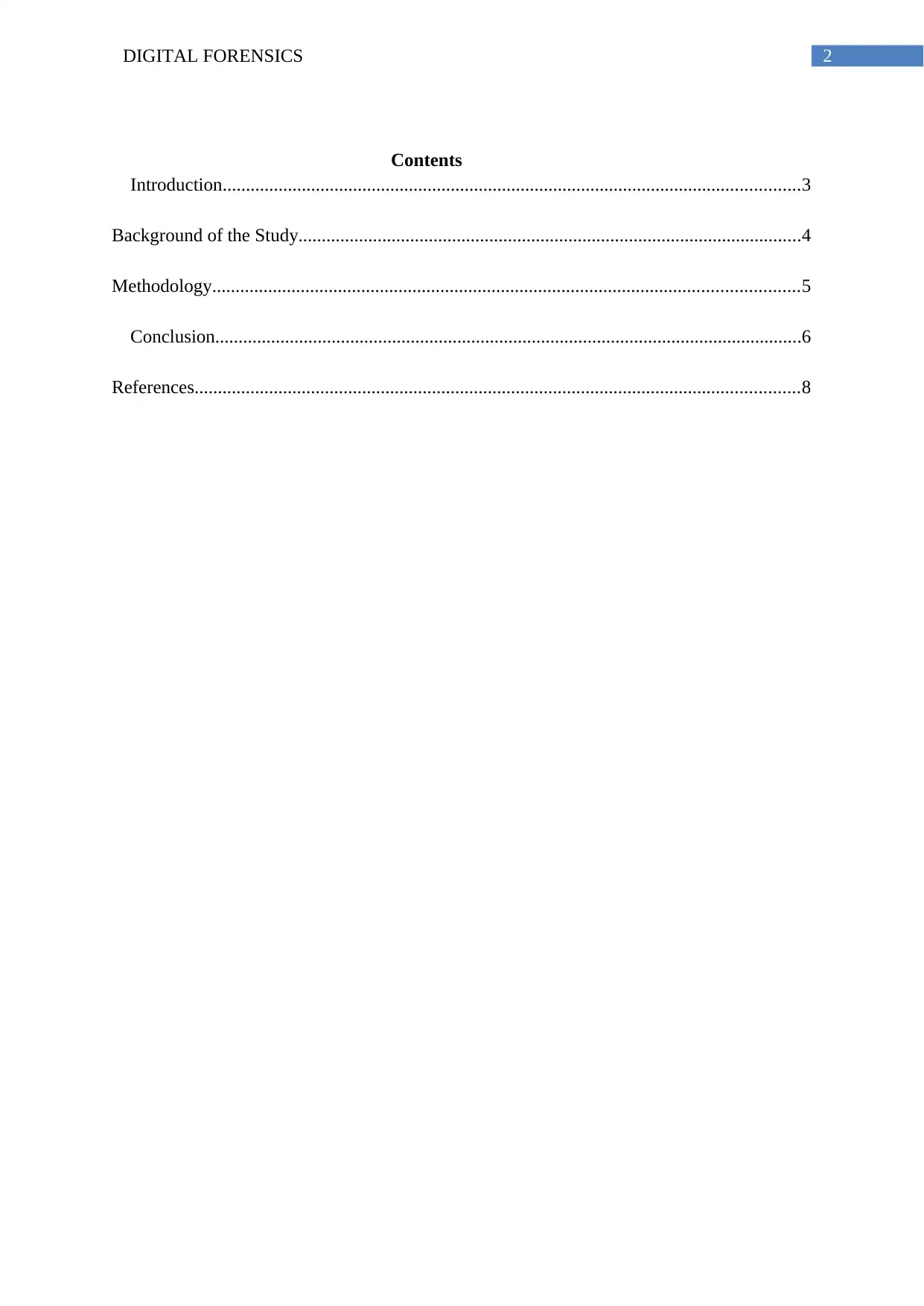
2DIGITAL FORENSICS
Contents
Introduction............................................................................................................................3
Background of the Study............................................................................................................4
Methodology..............................................................................................................................5
Conclusion..............................................................................................................................6
References..................................................................................................................................8
Contents
Introduction............................................................................................................................3
Background of the Study............................................................................................................4
Methodology..............................................................................................................................5
Conclusion..............................................................................................................................6
References..................................................................................................................................8
⊘ This is a preview!⊘
Do you want full access?
Subscribe today to unlock all pages.

Trusted by 1+ million students worldwide
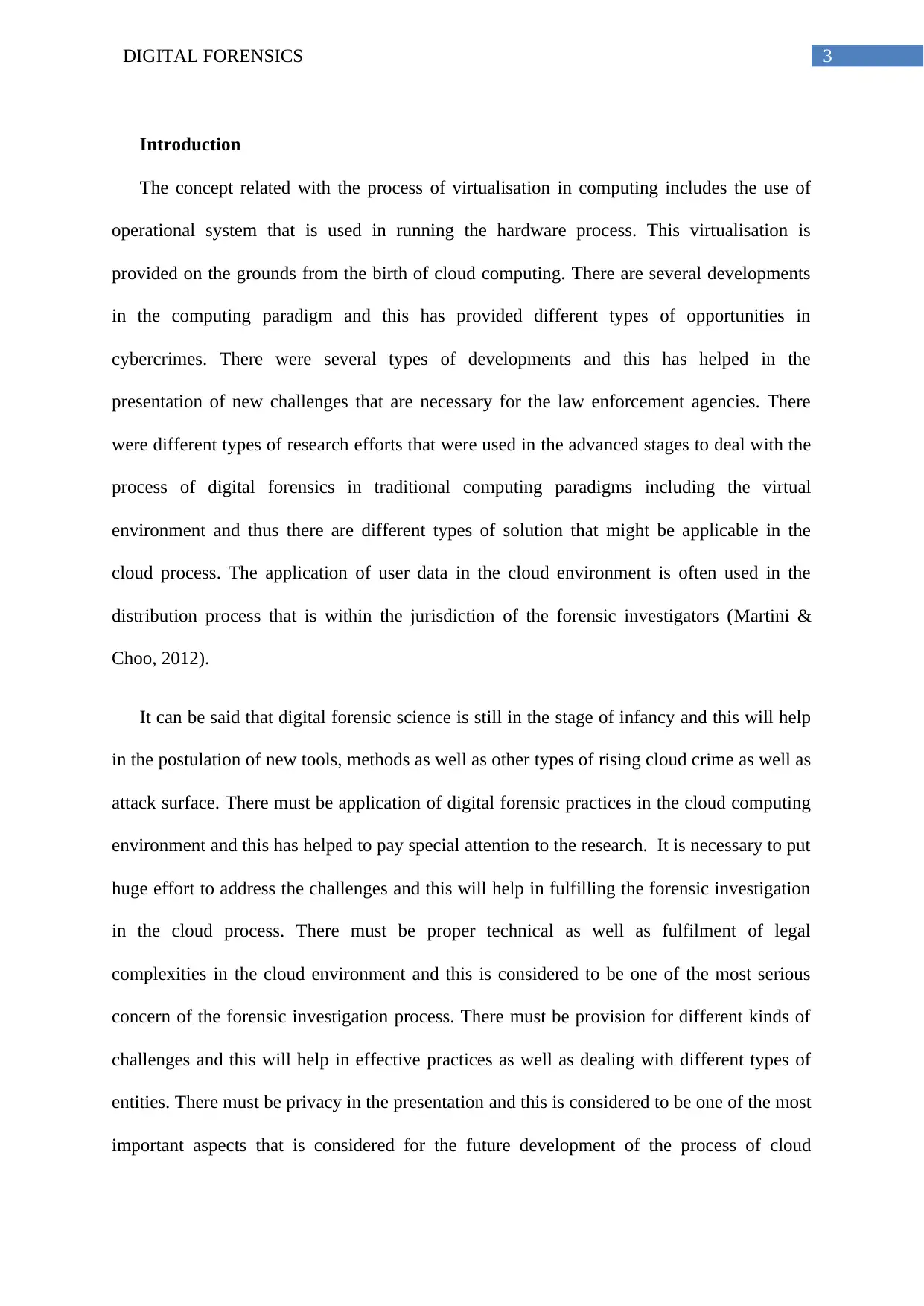
3DIGITAL FORENSICS
Introduction
The concept related with the process of virtualisation in computing includes the use of
operational system that is used in running the hardware process. This virtualisation is
provided on the grounds from the birth of cloud computing. There are several developments
in the computing paradigm and this has provided different types of opportunities in
cybercrimes. There were several types of developments and this has helped in the
presentation of new challenges that are necessary for the law enforcement agencies. There
were different types of research efforts that were used in the advanced stages to deal with the
process of digital forensics in traditional computing paradigms including the virtual
environment and thus there are different types of solution that might be applicable in the
cloud process. The application of user data in the cloud environment is often used in the
distribution process that is within the jurisdiction of the forensic investigators (Martini &
Choo, 2012).
It can be said that digital forensic science is still in the stage of infancy and this will help
in the postulation of new tools, methods as well as other types of rising cloud crime as well as
attack surface. There must be application of digital forensic practices in the cloud computing
environment and this has helped to pay special attention to the research. It is necessary to put
huge effort to address the challenges and this will help in fulfilling the forensic investigation
in the cloud process. There must be proper technical as well as fulfilment of legal
complexities in the cloud environment and this is considered to be one of the most serious
concern of the forensic investigation process. There must be provision for different kinds of
challenges and this will help in effective practices as well as dealing with different types of
entities. There must be privacy in the presentation and this is considered to be one of the most
important aspects that is considered for the future development of the process of cloud
Introduction
The concept related with the process of virtualisation in computing includes the use of
operational system that is used in running the hardware process. This virtualisation is
provided on the grounds from the birth of cloud computing. There are several developments
in the computing paradigm and this has provided different types of opportunities in
cybercrimes. There were several types of developments and this has helped in the
presentation of new challenges that are necessary for the law enforcement agencies. There
were different types of research efforts that were used in the advanced stages to deal with the
process of digital forensics in traditional computing paradigms including the virtual
environment and thus there are different types of solution that might be applicable in the
cloud process. The application of user data in the cloud environment is often used in the
distribution process that is within the jurisdiction of the forensic investigators (Martini &
Choo, 2012).
It can be said that digital forensic science is still in the stage of infancy and this will help
in the postulation of new tools, methods as well as other types of rising cloud crime as well as
attack surface. There must be application of digital forensic practices in the cloud computing
environment and this has helped to pay special attention to the research. It is necessary to put
huge effort to address the challenges and this will help in fulfilling the forensic investigation
in the cloud process. There must be proper technical as well as fulfilment of legal
complexities in the cloud environment and this is considered to be one of the most serious
concern of the forensic investigation process. There must be provision for different kinds of
challenges and this will help in effective practices as well as dealing with different types of
entities. There must be privacy in the presentation and this is considered to be one of the most
important aspects that is considered for the future development of the process of cloud
Paraphrase This Document
Need a fresh take? Get an instant paraphrase of this document with our AI Paraphraser
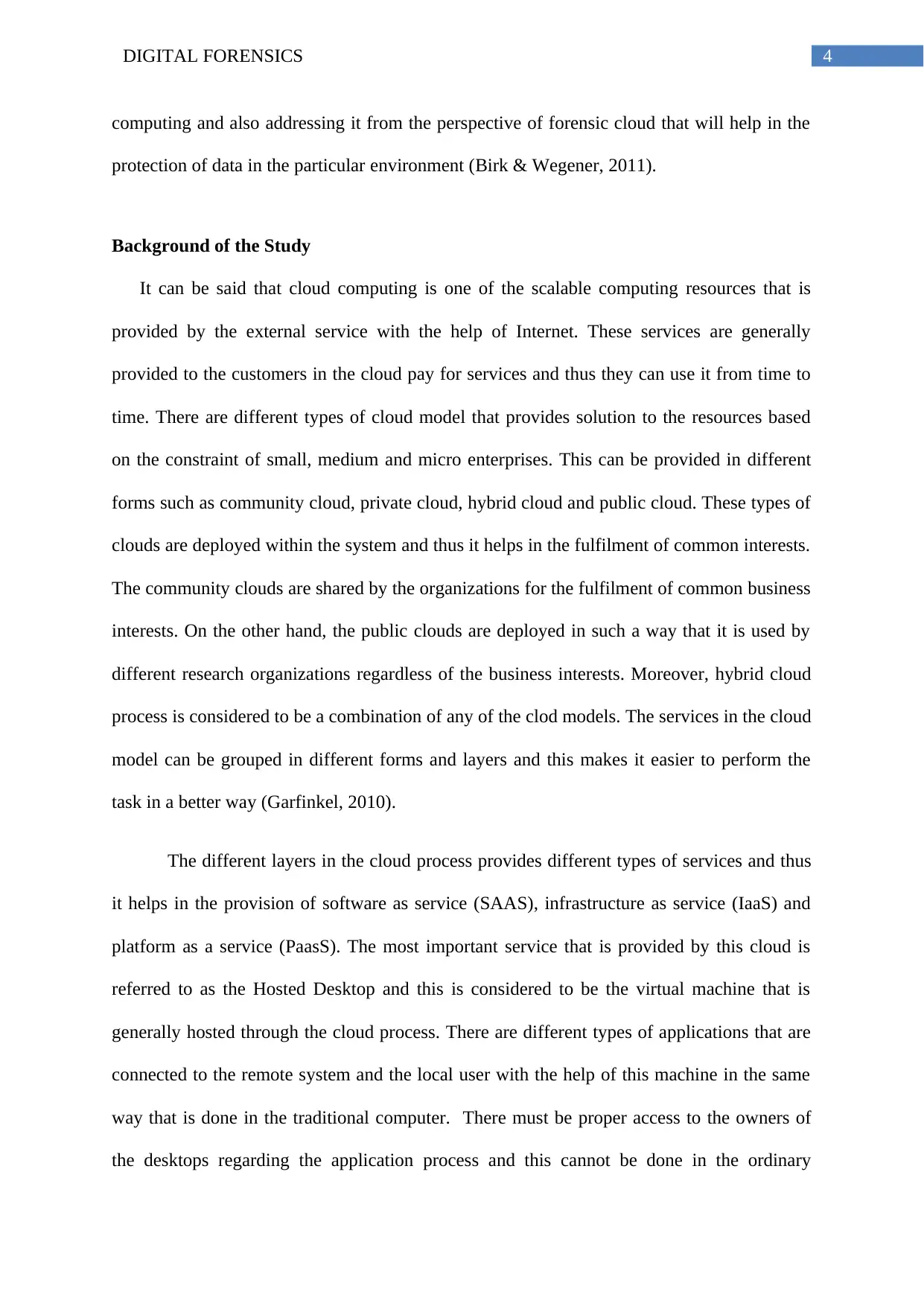
4DIGITAL FORENSICS
computing and also addressing it from the perspective of forensic cloud that will help in the
protection of data in the particular environment (Birk & Wegener, 2011).
Background of the Study
It can be said that cloud computing is one of the scalable computing resources that is
provided by the external service with the help of Internet. These services are generally
provided to the customers in the cloud pay for services and thus they can use it from time to
time. There are different types of cloud model that provides solution to the resources based
on the constraint of small, medium and micro enterprises. This can be provided in different
forms such as community cloud, private cloud, hybrid cloud and public cloud. These types of
clouds are deployed within the system and thus it helps in the fulfilment of common interests.
The community clouds are shared by the organizations for the fulfilment of common business
interests. On the other hand, the public clouds are deployed in such a way that it is used by
different research organizations regardless of the business interests. Moreover, hybrid cloud
process is considered to be a combination of any of the clod models. The services in the cloud
model can be grouped in different forms and layers and this makes it easier to perform the
task in a better way (Garfinkel, 2010).
The different layers in the cloud process provides different types of services and thus
it helps in the provision of software as service (SAAS), infrastructure as service (IaaS) and
platform as a service (PaasS). The most important service that is provided by this cloud is
referred to as the Hosted Desktop and this is considered to be the virtual machine that is
generally hosted through the cloud process. There are different types of applications that are
connected to the remote system and the local user with the help of this machine in the same
way that is done in the traditional computer. There must be proper access to the owners of
the desktops regarding the application process and this cannot be done in the ordinary
computing and also addressing it from the perspective of forensic cloud that will help in the
protection of data in the particular environment (Birk & Wegener, 2011).
Background of the Study
It can be said that cloud computing is one of the scalable computing resources that is
provided by the external service with the help of Internet. These services are generally
provided to the customers in the cloud pay for services and thus they can use it from time to
time. There are different types of cloud model that provides solution to the resources based
on the constraint of small, medium and micro enterprises. This can be provided in different
forms such as community cloud, private cloud, hybrid cloud and public cloud. These types of
clouds are deployed within the system and thus it helps in the fulfilment of common interests.
The community clouds are shared by the organizations for the fulfilment of common business
interests. On the other hand, the public clouds are deployed in such a way that it is used by
different research organizations regardless of the business interests. Moreover, hybrid cloud
process is considered to be a combination of any of the clod models. The services in the cloud
model can be grouped in different forms and layers and this makes it easier to perform the
task in a better way (Garfinkel, 2010).
The different layers in the cloud process provides different types of services and thus
it helps in the provision of software as service (SAAS), infrastructure as service (IaaS) and
platform as a service (PaasS). The most important service that is provided by this cloud is
referred to as the Hosted Desktop and this is considered to be the virtual machine that is
generally hosted through the cloud process. There are different types of applications that are
connected to the remote system and the local user with the help of this machine in the same
way that is done in the traditional computer. There must be proper access to the owners of
the desktops regarding the application process and this cannot be done in the ordinary
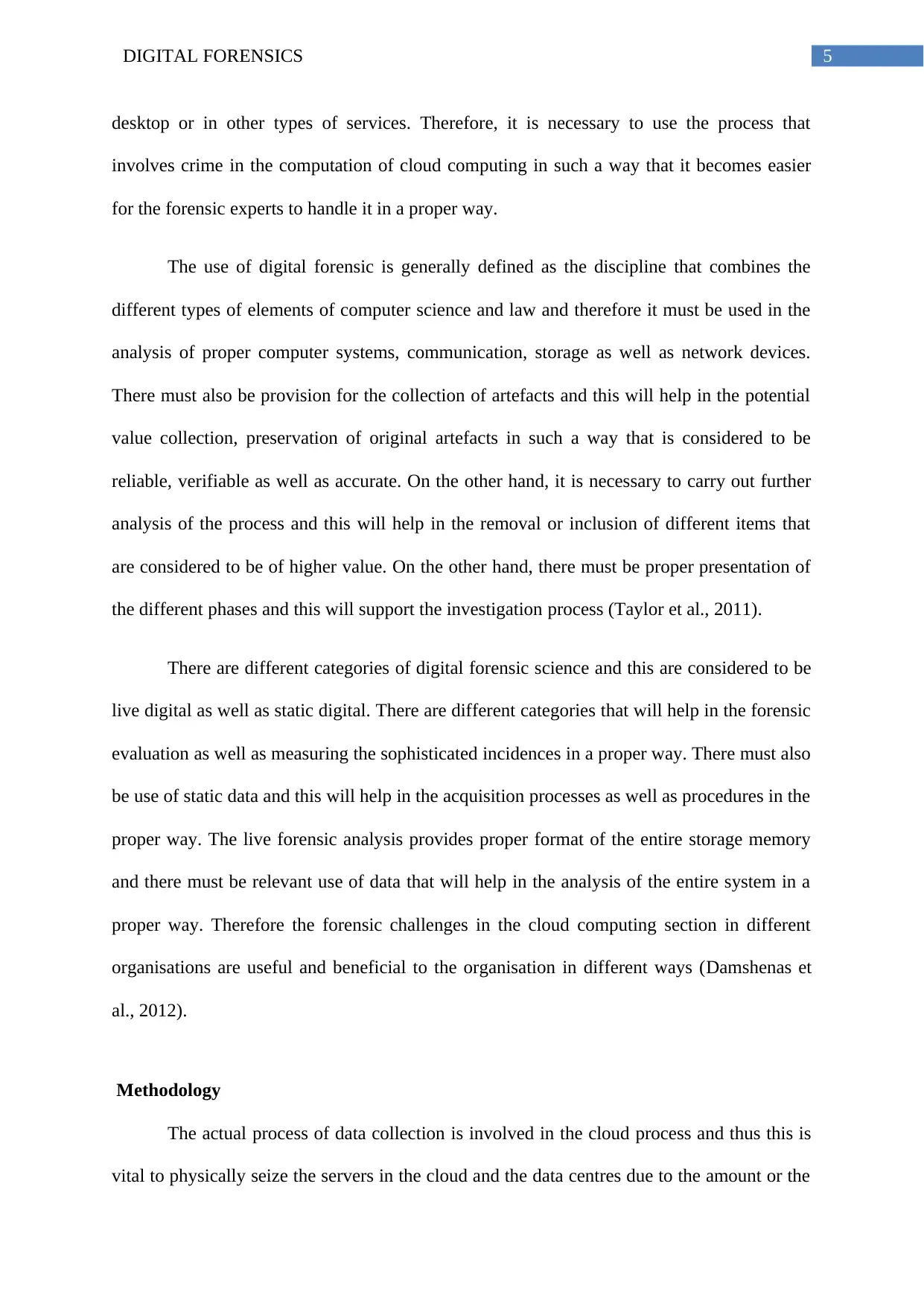
5DIGITAL FORENSICS
desktop or in other types of services. Therefore, it is necessary to use the process that
involves crime in the computation of cloud computing in such a way that it becomes easier
for the forensic experts to handle it in a proper way.
The use of digital forensic is generally defined as the discipline that combines the
different types of elements of computer science and law and therefore it must be used in the
analysis of proper computer systems, communication, storage as well as network devices.
There must also be provision for the collection of artefacts and this will help in the potential
value collection, preservation of original artefacts in such a way that is considered to be
reliable, verifiable as well as accurate. On the other hand, it is necessary to carry out further
analysis of the process and this will help in the removal or inclusion of different items that
are considered to be of higher value. On the other hand, there must be proper presentation of
the different phases and this will support the investigation process (Taylor et al., 2011).
There are different categories of digital forensic science and this are considered to be
live digital as well as static digital. There are different categories that will help in the forensic
evaluation as well as measuring the sophisticated incidences in a proper way. There must also
be use of static data and this will help in the acquisition processes as well as procedures in the
proper way. The live forensic analysis provides proper format of the entire storage memory
and there must be relevant use of data that will help in the analysis of the entire system in a
proper way. Therefore the forensic challenges in the cloud computing section in different
organisations are useful and beneficial to the organisation in different ways (Damshenas et
al., 2012).
Methodology
The actual process of data collection is involved in the cloud process and thus this is
vital to physically seize the servers in the cloud and the data centres due to the amount or the
desktop or in other types of services. Therefore, it is necessary to use the process that
involves crime in the computation of cloud computing in such a way that it becomes easier
for the forensic experts to handle it in a proper way.
The use of digital forensic is generally defined as the discipline that combines the
different types of elements of computer science and law and therefore it must be used in the
analysis of proper computer systems, communication, storage as well as network devices.
There must also be provision for the collection of artefacts and this will help in the potential
value collection, preservation of original artefacts in such a way that is considered to be
reliable, verifiable as well as accurate. On the other hand, it is necessary to carry out further
analysis of the process and this will help in the removal or inclusion of different items that
are considered to be of higher value. On the other hand, there must be proper presentation of
the different phases and this will support the investigation process (Taylor et al., 2011).
There are different categories of digital forensic science and this are considered to be
live digital as well as static digital. There are different categories that will help in the forensic
evaluation as well as measuring the sophisticated incidences in a proper way. There must also
be use of static data and this will help in the acquisition processes as well as procedures in the
proper way. The live forensic analysis provides proper format of the entire storage memory
and there must be relevant use of data that will help in the analysis of the entire system in a
proper way. Therefore the forensic challenges in the cloud computing section in different
organisations are useful and beneficial to the organisation in different ways (Damshenas et
al., 2012).
Methodology
The actual process of data collection is involved in the cloud process and thus this is
vital to physically seize the servers in the cloud and the data centres due to the amount or the
⊘ This is a preview!⊘
Do you want full access?
Subscribe today to unlock all pages.

Trusted by 1+ million students worldwide
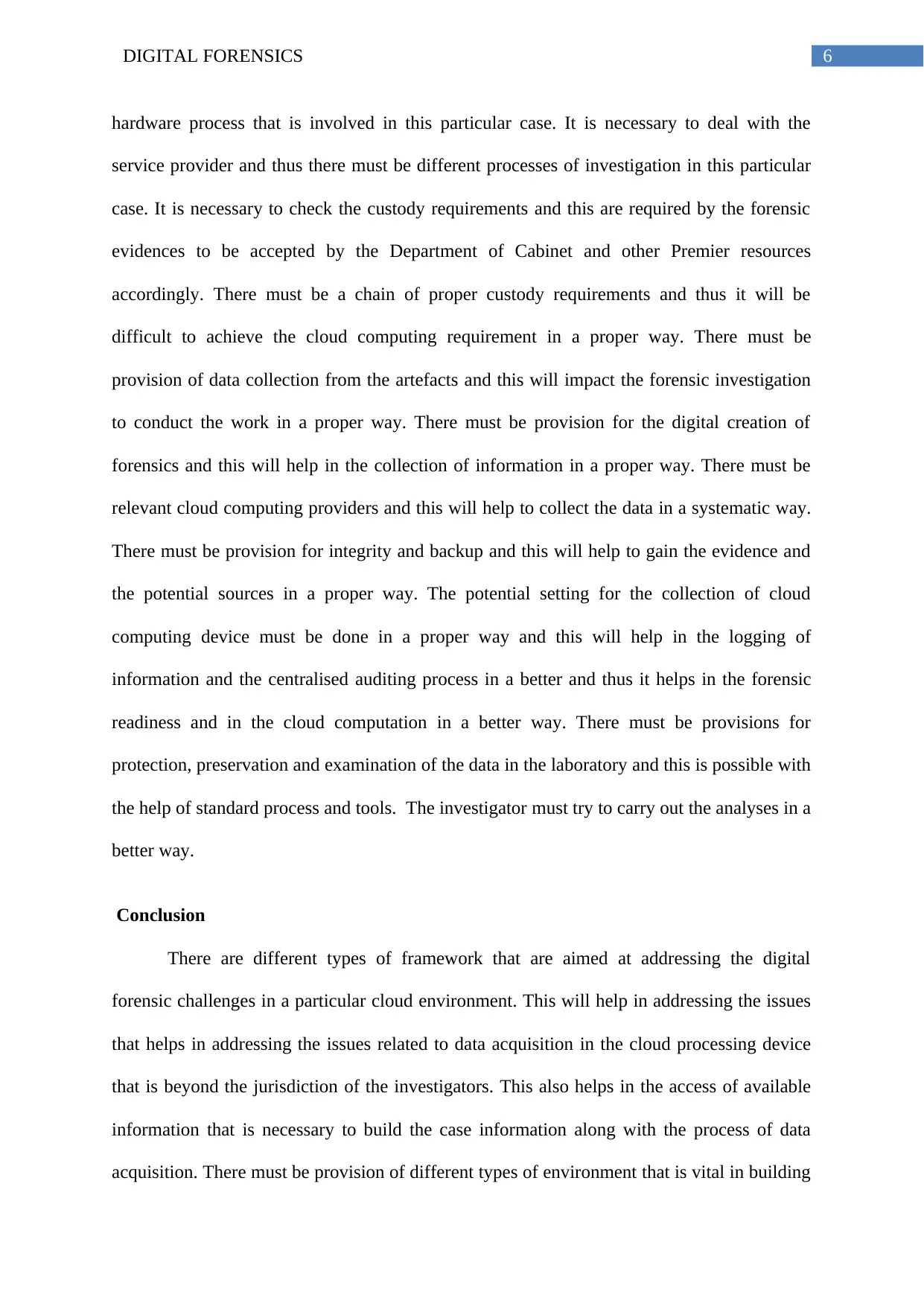
6DIGITAL FORENSICS
hardware process that is involved in this particular case. It is necessary to deal with the
service provider and thus there must be different processes of investigation in this particular
case. It is necessary to check the custody requirements and this are required by the forensic
evidences to be accepted by the Department of Cabinet and other Premier resources
accordingly. There must be a chain of proper custody requirements and thus it will be
difficult to achieve the cloud computing requirement in a proper way. There must be
provision of data collection from the artefacts and this will impact the forensic investigation
to conduct the work in a proper way. There must be provision for the digital creation of
forensics and this will help in the collection of information in a proper way. There must be
relevant cloud computing providers and this will help to collect the data in a systematic way.
There must be provision for integrity and backup and this will help to gain the evidence and
the potential sources in a proper way. The potential setting for the collection of cloud
computing device must be done in a proper way and this will help in the logging of
information and the centralised auditing process in a better and thus it helps in the forensic
readiness and in the cloud computation in a better way. There must be provisions for
protection, preservation and examination of the data in the laboratory and this is possible with
the help of standard process and tools. The investigator must try to carry out the analyses in a
better way.
Conclusion
There are different types of framework that are aimed at addressing the digital
forensic challenges in a particular cloud environment. This will help in addressing the issues
that helps in addressing the issues related to data acquisition in the cloud processing device
that is beyond the jurisdiction of the investigators. This also helps in the access of available
information that is necessary to build the case information along with the process of data
acquisition. There must be provision of different types of environment that is vital in building
hardware process that is involved in this particular case. It is necessary to deal with the
service provider and thus there must be different processes of investigation in this particular
case. It is necessary to check the custody requirements and this are required by the forensic
evidences to be accepted by the Department of Cabinet and other Premier resources
accordingly. There must be a chain of proper custody requirements and thus it will be
difficult to achieve the cloud computing requirement in a proper way. There must be
provision of data collection from the artefacts and this will impact the forensic investigation
to conduct the work in a proper way. There must be provision for the digital creation of
forensics and this will help in the collection of information in a proper way. There must be
relevant cloud computing providers and this will help to collect the data in a systematic way.
There must be provision for integrity and backup and this will help to gain the evidence and
the potential sources in a proper way. The potential setting for the collection of cloud
computing device must be done in a proper way and this will help in the logging of
information and the centralised auditing process in a better and thus it helps in the forensic
readiness and in the cloud computation in a better way. There must be provisions for
protection, preservation and examination of the data in the laboratory and this is possible with
the help of standard process and tools. The investigator must try to carry out the analyses in a
better way.
Conclusion
There are different types of framework that are aimed at addressing the digital
forensic challenges in a particular cloud environment. This will help in addressing the issues
that helps in addressing the issues related to data acquisition in the cloud processing device
that is beyond the jurisdiction of the investigators. This also helps in the access of available
information that is necessary to build the case information along with the process of data
acquisition. There must be provision of different types of environment that is vital in building
Paraphrase This Document
Need a fresh take? Get an instant paraphrase of this document with our AI Paraphraser
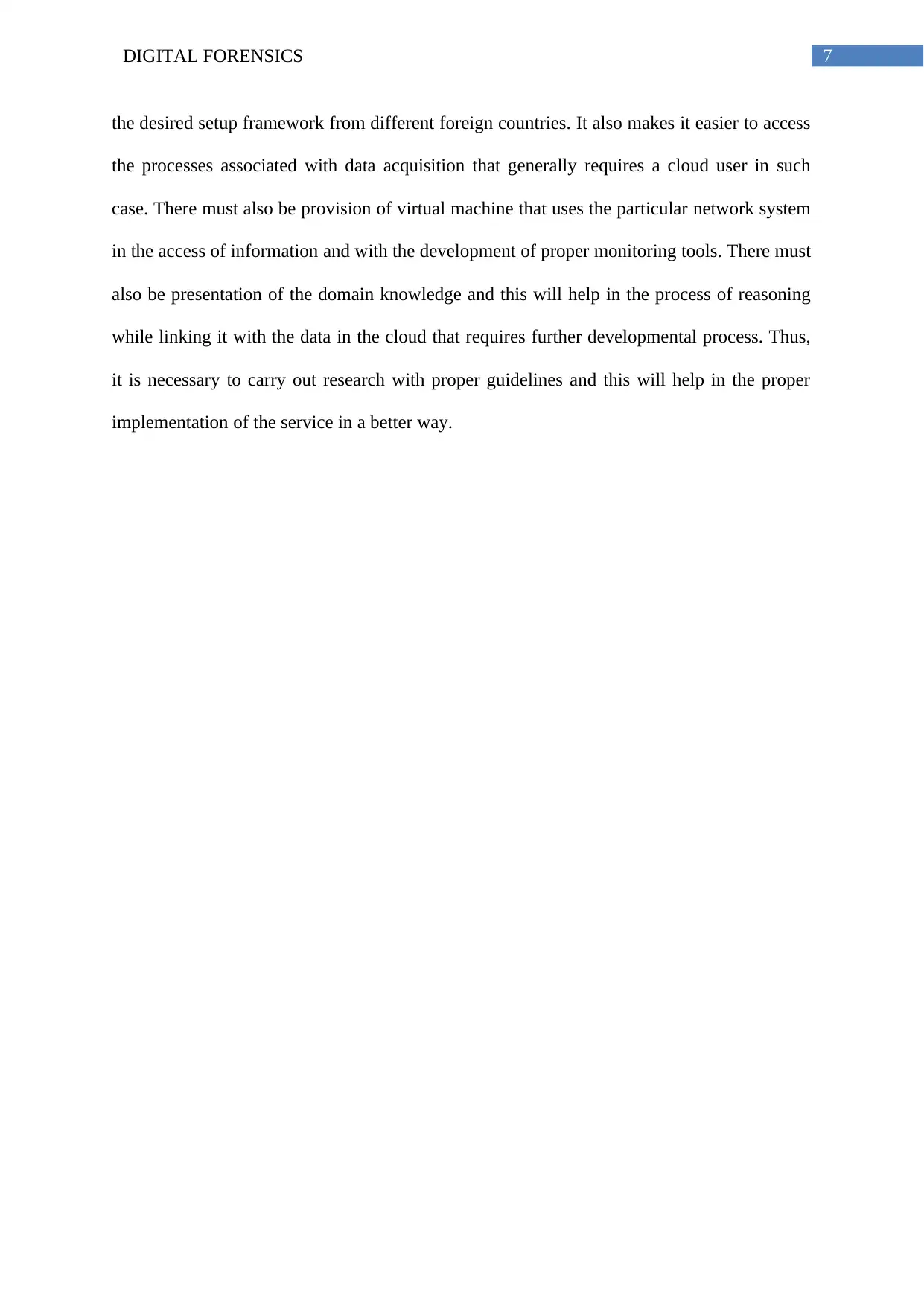
7DIGITAL FORENSICS
the desired setup framework from different foreign countries. It also makes it easier to access
the processes associated with data acquisition that generally requires a cloud user in such
case. There must also be provision of virtual machine that uses the particular network system
in the access of information and with the development of proper monitoring tools. There must
also be presentation of the domain knowledge and this will help in the process of reasoning
while linking it with the data in the cloud that requires further developmental process. Thus,
it is necessary to carry out research with proper guidelines and this will help in the proper
implementation of the service in a better way.
the desired setup framework from different foreign countries. It also makes it easier to access
the processes associated with data acquisition that generally requires a cloud user in such
case. There must also be provision of virtual machine that uses the particular network system
in the access of information and with the development of proper monitoring tools. There must
also be presentation of the domain knowledge and this will help in the process of reasoning
while linking it with the data in the cloud that requires further developmental process. Thus,
it is necessary to carry out research with proper guidelines and this will help in the proper
implementation of the service in a better way.
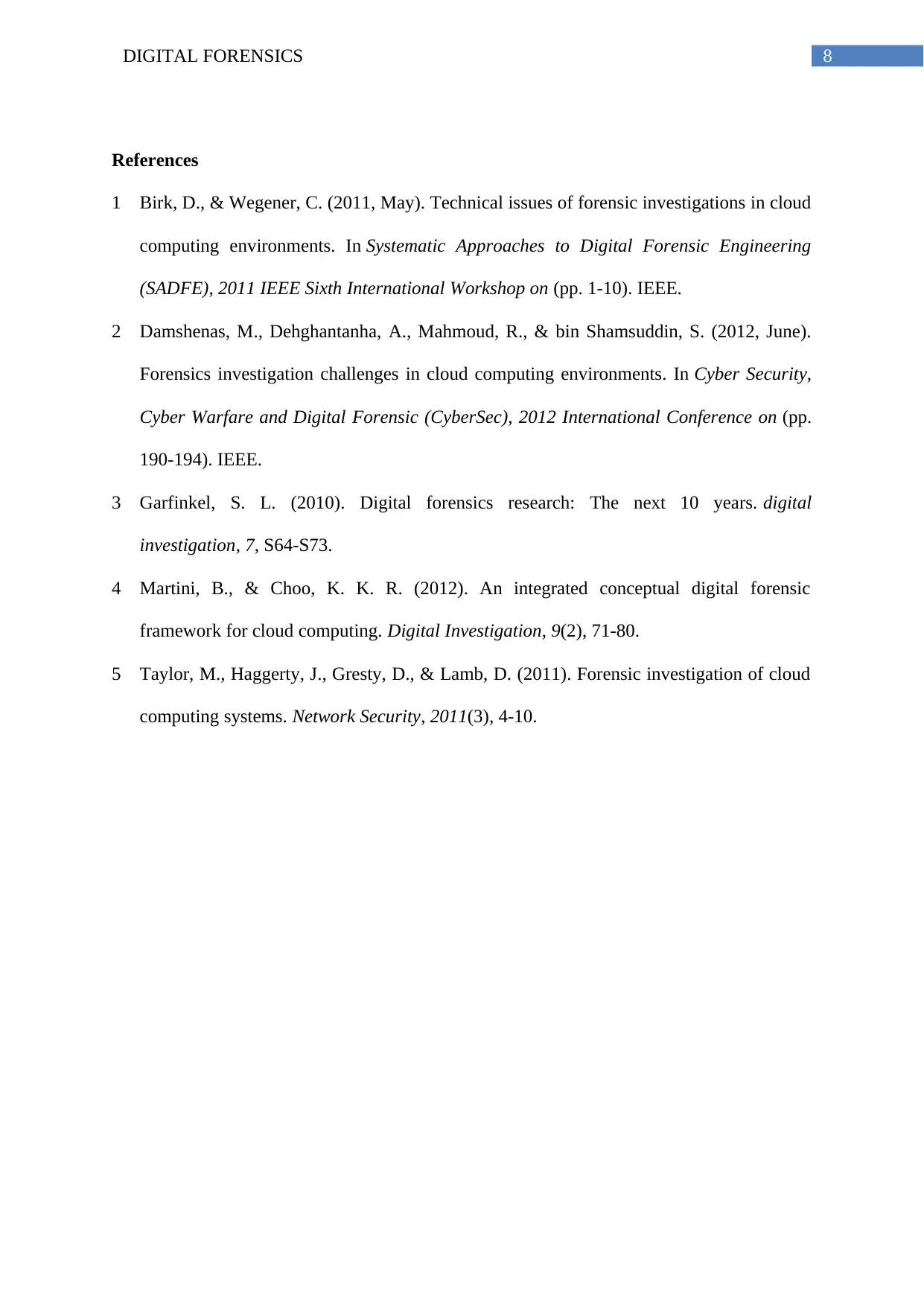
8DIGITAL FORENSICS
References
1 Birk, D., & Wegener, C. (2011, May). Technical issues of forensic investigations in cloud
computing environments. In Systematic Approaches to Digital Forensic Engineering
(SADFE), 2011 IEEE Sixth International Workshop on (pp. 1-10). IEEE.
2 Damshenas, M., Dehghantanha, A., Mahmoud, R., & bin Shamsuddin, S. (2012, June).
Forensics investigation challenges in cloud computing environments. In Cyber Security,
Cyber Warfare and Digital Forensic (CyberSec), 2012 International Conference on (pp.
190-194). IEEE.
3 Garfinkel, S. L. (2010). Digital forensics research: The next 10 years. digital
investigation, 7, S64-S73.
4 Martini, B., & Choo, K. K. R. (2012). An integrated conceptual digital forensic
framework for cloud computing. Digital Investigation, 9(2), 71-80.
5 Taylor, M., Haggerty, J., Gresty, D., & Lamb, D. (2011). Forensic investigation of cloud
computing systems. Network Security, 2011(3), 4-10.
References
1 Birk, D., & Wegener, C. (2011, May). Technical issues of forensic investigations in cloud
computing environments. In Systematic Approaches to Digital Forensic Engineering
(SADFE), 2011 IEEE Sixth International Workshop on (pp. 1-10). IEEE.
2 Damshenas, M., Dehghantanha, A., Mahmoud, R., & bin Shamsuddin, S. (2012, June).
Forensics investigation challenges in cloud computing environments. In Cyber Security,
Cyber Warfare and Digital Forensic (CyberSec), 2012 International Conference on (pp.
190-194). IEEE.
3 Garfinkel, S. L. (2010). Digital forensics research: The next 10 years. digital
investigation, 7, S64-S73.
4 Martini, B., & Choo, K. K. R. (2012). An integrated conceptual digital forensic
framework for cloud computing. Digital Investigation, 9(2), 71-80.
5 Taylor, M., Haggerty, J., Gresty, D., & Lamb, D. (2011). Forensic investigation of cloud
computing systems. Network Security, 2011(3), 4-10.
⊘ This is a preview!⊘
Do you want full access?
Subscribe today to unlock all pages.

Trusted by 1+ million students worldwide
1 out of 9
Related Documents
Your All-in-One AI-Powered Toolkit for Academic Success.
+13062052269
info@desklib.com
Available 24*7 on WhatsApp / Email
![[object Object]](/_next/static/media/star-bottom.7253800d.svg)
Unlock your academic potential
Copyright © 2020–2025 A2Z Services. All Rights Reserved. Developed and managed by ZUCOL.





